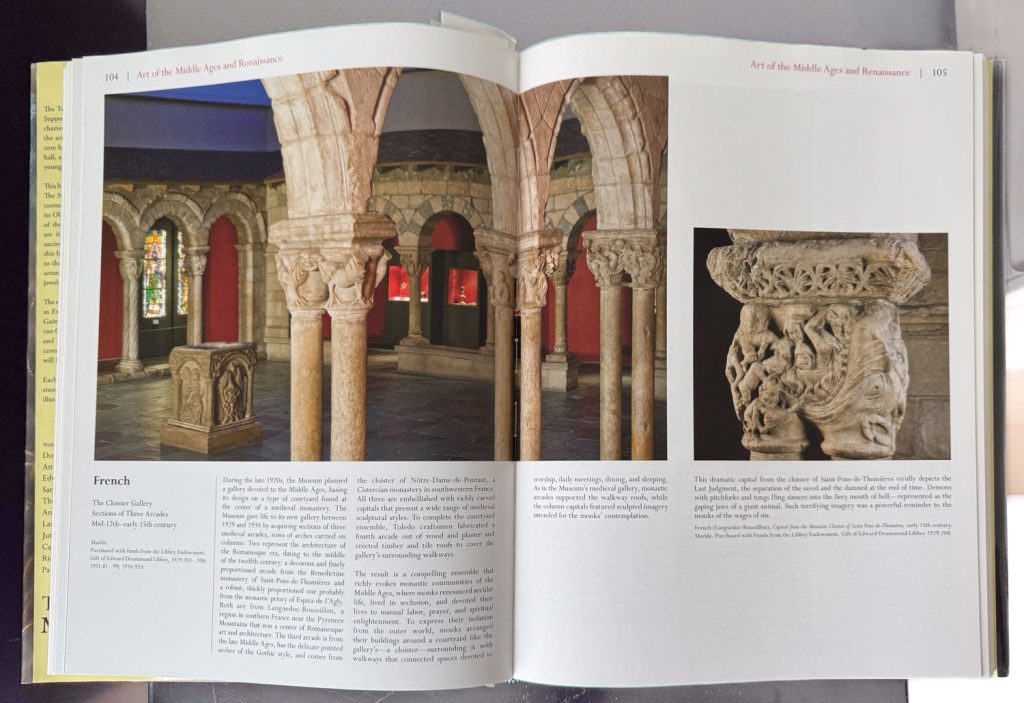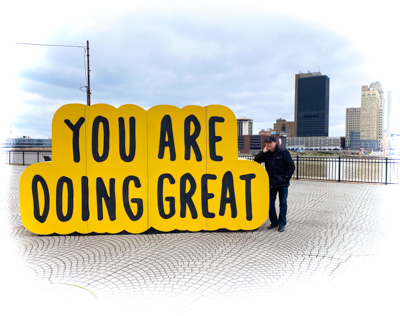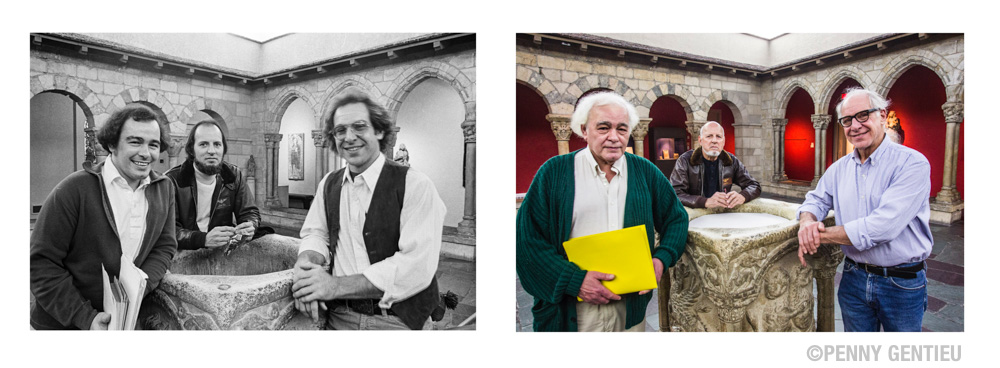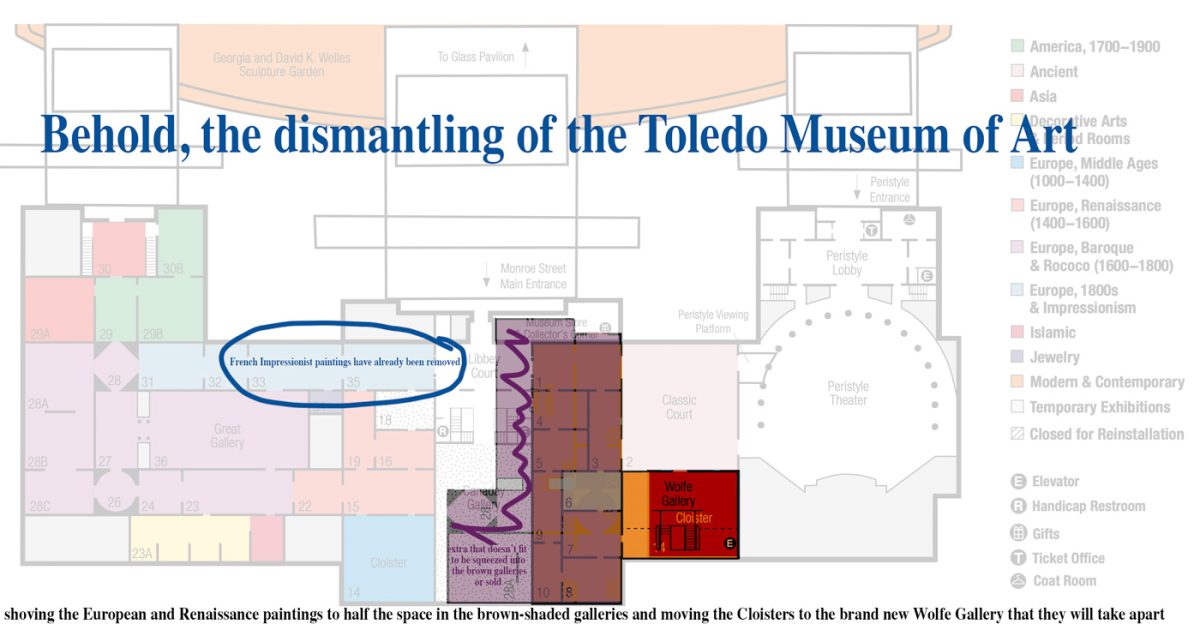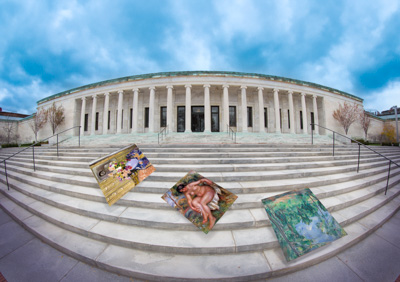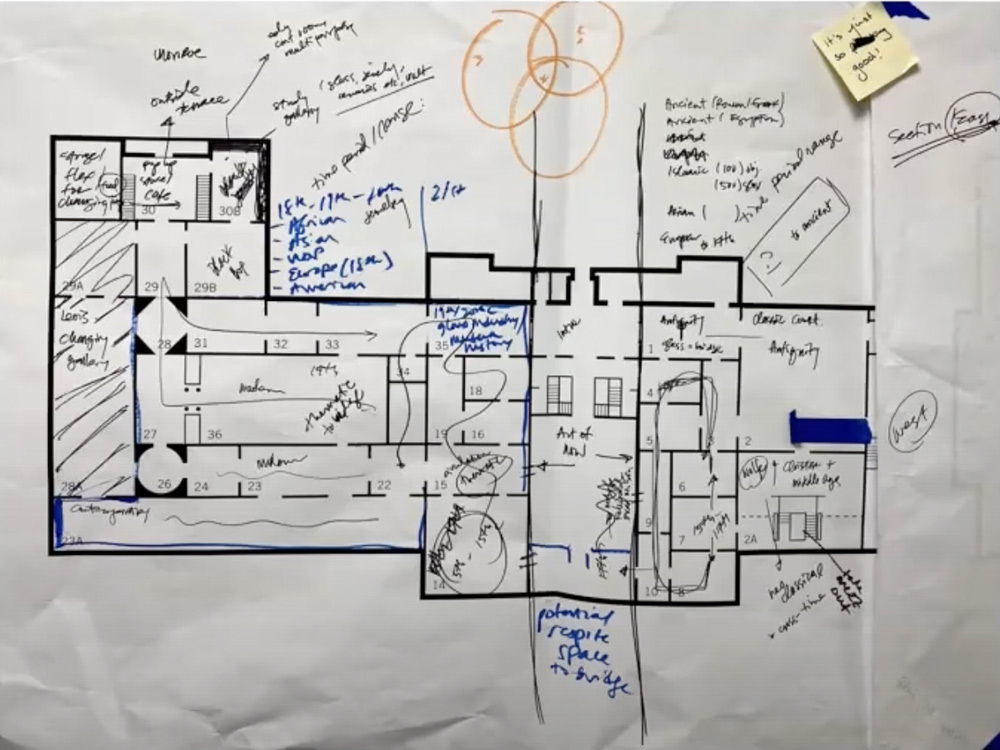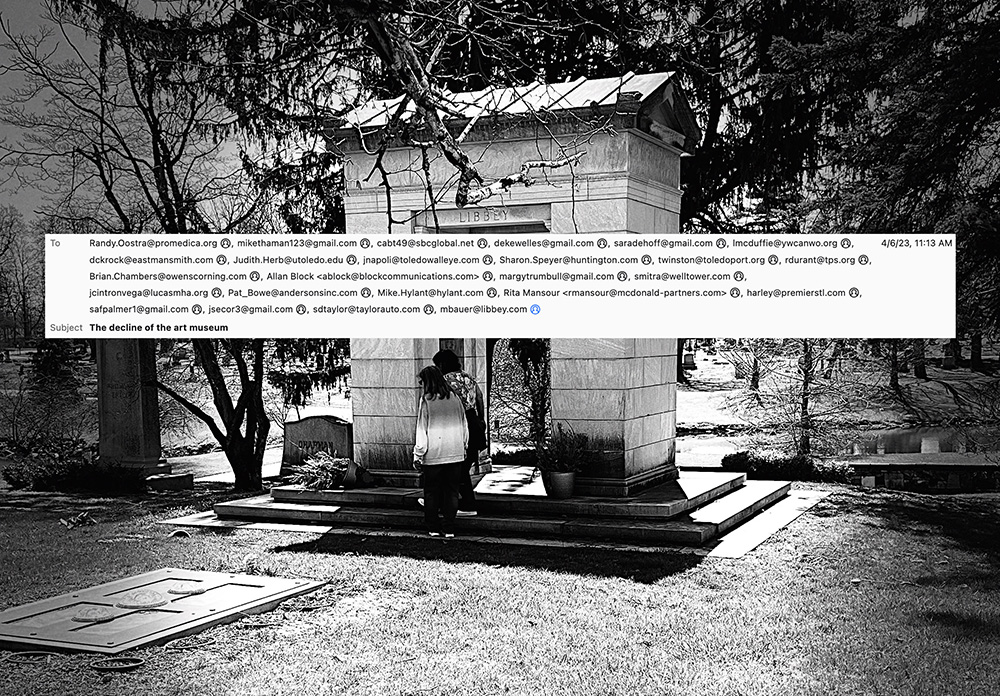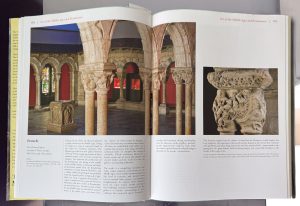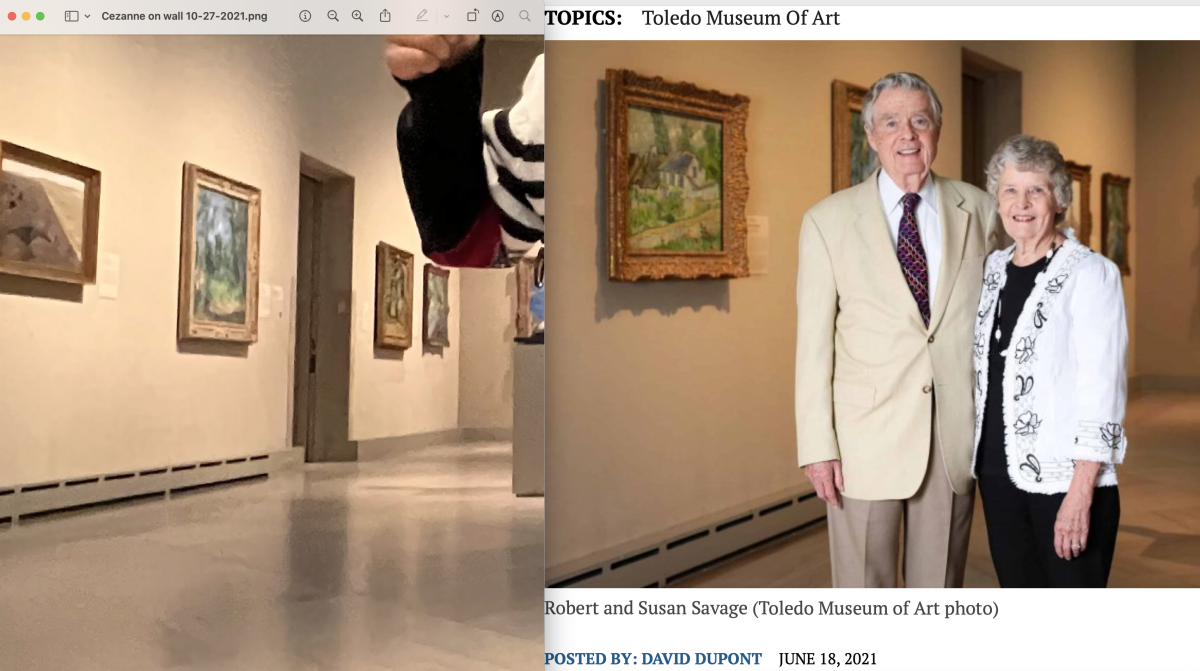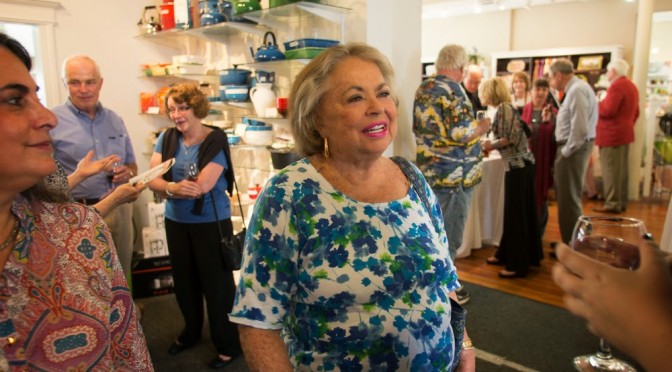It was the gift of Edward Drummond Libbey.
A one-year anniversary look-back.
Edward Drummond Libbey and Florence Scott Libbey gave their money to fund and start the Toledo Museum of Art, and to keep it going with stipulations made in their wills and trusts. The museum sold paintings that the Libbey Endowment paid for and started a new fund equal to the amount of the Libbey Endowment that takes the Libbeys out of the equation. In theory, the Toledo Museum of Art has always been Edward and Florence Libbey’s creation and gift to the city of Toledo. The current “stewards” of the museum are breaking their fiduciary duty to the museum and to the city of Toledo.
One year ago today, on May 17th, our valuable French Impressionist painting, The Glade by Paul Cezanne was sold at auction at Sotheby’s for $41.7 million, along with Matisse’s Fleurs ou Fleurs devant un portrait for $15.3 million, to the same mysterious buyer. Both of the paintings were bought with funds from the Edward Drummond Libbey Endowment. Renoir’s Nu s’essuyant (Bather), was also sold at auction, for $2.7 million, possibly thrown in as a red herring.

Although the museum has recently spread the rumor that this painting had been in storage in the museum’s basement for a long time, this photo, above, is proof that it was not in the basement. On the left is a section of a photo that I took on October 27, 2021, and on the right is a Toledo Museum of Art-credited photo of Bob and Sue Savage with the painting on the wall behind them. The photo of the Savages was used in a press release in regard to their recent donation and was published in at least one newspaper in June 2021, this found online on the BG Independent News.
The current so-called “stewards” of our museum took the Cezanne painting right off the wall of Gallery 33 and shipped it to Sotheby’s. But it was an important painting. Cezanne is considered the father of modern art. It was one of the first paintings a person would see when they visited the Toledo Museum of Art.
We were told this:
The director, Adam Levine and the board members and other so-called museum “stewards” as well as an outside consultant took a vote as to which of the two Cezanne paintings that the museum owned they thought was the best, The Glade or Avenue at Chantilly. They all decided that Avenue at Chantilly was the best. So then they told us that the museum had never intended to have multiple examples of an artist, so they were selling The Glade, along with an “extra” Matisse, as well as the Renoir painting of the nude bather that was apparently too similar to the Renoir sculpture of the nude bather in their collection. Adam Levine told us that Edward Drummond Libbey would want them to get rid of the Cezanne, Matisse and Renoir because they were mediocre, invoking Libbey in this quote:
As Edward Drummond Libbey put it in 1912: “Let the multitudinous array of the mediocre be relegated to the past and in its place be found the highest quality, the best examples and the recognition of only those thoughts which will stand for all time.”
Announced only 38 days before the auction, Toledoans protested the sale. The Blade and the Los Angeles Times published editorials against the sale. The Blade wrote that it doesn’t make sense to deaccession the museum’s best paintings, and that as the museum represents Toledo, they shouldn’t be selling them. The Los Angeles Times wrote in authoritative detail that the deaccession was unconscionable. But it didn’t stop our museum “stewards,” because the museum had arranged with Sotheby’s for it to be a done deal. Our “stewards” stipulated the auctioned paintings to be “Guaranteed Property” with “Irrevocable Bids.” If the paintings didn’t sell, they became the property of Sotheby’s.
How important was our Cezanne?
It was very important. Here it is on the cover of Museum News after it was acquired in 1942, and the text.

Museum News March 1943 – download PDF here
ADDED TO THE LIBBEY COLLECTION
LANDSCAPE by Cezanne brings to the Toledo Museum the union of nature and an intellect especially attuned to it. Here is a man who worked always from fact and expanded it enormously by his understanding. When morning lights the southern wall of Gallery Twenty-four, The Glade admits us to its spell. Sit down for twenty minutes and enjoy it without effort or prejudice, as if pausing here to await a friend on a morning’s walk. Surely a simple landscape, this place where we choose to rest. Sunlight laps the warm earth at our feet; the low scrub flares into second-growth trees, none of them remarkable for size or majesty. Yet the place has elemental grandeur; this small area is instinct with sun and wind, the joy and sparkle, the grace and severity of life itself. Through to the left opens a little vista, made more intriguing by the slender tree that cuts our view. Trunks at the right have grown aslant toward the sunlight. Cezanne was deeply conscious of his “sensations in the presence of nature” and he is able to convey them to us in the surface sparkle of his brilliant brushwork and the solid foundations of form and space and volume that compose this world about us. These sapling trunks fling pyramids of foliage on the summer air. Between them pulses heat and light. Tree after tree separates itself from the mass and takes on individuality. Far to the left, the sun strikes the ruddy earth once more. The distance grows with contemplation.
Beside the Cezanne hangs a landscape by Monet, and we learn to see more truly if we compare the two, the Monet representing the high tide of Impressionist painting, and the Cezanne still Impressionist but with instinctive turn toward those more solid qualities which were to rebuild international art in our time. Monet’s objective was light and atmosphere, colors laid side by side, not mixed on a palette, but fused by our eyesight to more sparkling vivacity. Monet in this canvas shows more of heat and sun and shimmer, but the distance down The Glade is more firmly defined than are Monet’s miles across the bay to Antibes. Cezanne’s trees toss more solid form into the air than Monet cared to give to the very walls and towers of his city. Monet’s summer day is the gayer of the two, more lyric, not so epic as the Cezanne of darker majesty. Turn to the left of the Glade and you will see the work of Pissarro, with whom Cezanne painted the summers of 1873 and 1874 at Auvers. From this older French master stems Cezanne’s only recognizable heritage in art. From him he learned to look with care at the world before him and to be more aware of nature than introspective in his vision. Pissaro’s methods of painting were effective, flexible and assured, and Cezanne went on to develop them further into his own idiom.
Cezanne said, “I wish to make of Impressionism something solid and durable like the art of museums.” He worked a lifetime from dawn to twilight to keep the light and atmosphere at their height yet give them a foundation of geometric forms, the solid structure of all things, set in resounding space. Volume and space were aims in some degree of most masters in the history of art, yet Cezanne unified these objectives and knit them into a single powerful restatement, from which derives much international art of our time. All artists today who emphasize three dimensions, all those who go deeper than decorative surfaces, all modern artists are somewhat different since Cezanne lived his years of unremitting work from 1873 to 1906. Some artists can only reflect the great; being devoid of creative gifts themselves, they add nothing of their own temperament. Other imaginations speak their own native dialect of the Cezanne language. None would have painted the same, had not this quiet, shy man lived before them. The Glade gains its form through Cezanne’s minute observation of color. His eye took in not only the local color inherent in an object, and the colors reflected upon it by surroundings, but the subtle changes of hue which shape for our eye the recession and turn of surfaces which enclose the volumes of reality. He pursues these manifold aims with innate simplicity and discretion. So interwoven is the resulting fabric of color, texture, volume, and space that no one aspect of the creation breaks through the grave composure of the whole. Minute and unremitting was his scrutiny of nature. Across the surface of his canvas flickers unceasing life compounded of transparent slender brushstrokes. Effects were built up, layer upon layer, hour after hour of slow contemplation, conviction, action. Often his brush was washed in turpentine between strokes to keep his color more exact and pure. Slow work and humble effort and absorbed devotion to nature filled his life to the exclusion of all but a few friends, his wife and affectionate son. From 1892 to 1896 he painted in the forest of Fontainebleau and along the river Marne. Some time he passed at Aix in Provence. As The Glade would seem to have been painted between these years, we are not sure of its exact locale. Perhaps near Aix or not far from Paris he found this clearing circled by rich green. Landscapes are frequent in his masterly production. A writer has compared his canvases with photographs of the scenes he chose to paint. He can see with striking clarity how much Cezanne’s vision simplified and reinforced the salient facts of nature. From her casual vegetation he developed a vast and solid structure of space, volumes, dramatic sequence of related objects.
Because of his methods of work, his exceedingly patient analysis of nature, this artist had need of equal patience in all his subjects. His great still life compositions are instinct with apples, bottles, clocks, fabrics whose complete lack of motion is but one step beyond the painter’s exceedingly slow method of painting them. His still lifes are among the most remarkable of all time. Resolute and personable, these inanimate objects take on a majestic finality which is the reward of his intellectual and sensitive perception and translation of a three-dimensional world into the two dimensions of the picture plane. His portraits are equally magnificent, forceful and direct. They are limited to the figures of friends, those relatives or devoted ones who could be asked for even a hundred and fifteen hours of unflinching quiet, as was Vollard. A village group sat absorbed by their cards day after day while Cezanne immortalized them as The Card Players. The nude attracted him throughout his life, but with slight success due to the hazards inherent in his dream of having large groups of unclothed models motionless for long periods outdoors in a provincial society. He was too sincere to paint them in the comfort of a studio and by imagination surround them with the light of heaven. Born to security beneath the rule of his most autocratic father, he was always assured of funds for a modest existence. Later inheritance brought him comparative wealth, but he continued a simple life, devoid of ornament. Sincere and shy, despite profound intelligence, he guarded his independence and in isolation dedicated himself to research in vision and paint. We learn the truth direct from the words of an artist and so can picture Cezanne profligate with paint, squeezing the luscious tubes of expensive colors and exclaiming, “ I paint as if I were Rothschild!” And, more seriously, “I live under the impact of sensations. I go ahead very slowly, as nature appears very complex to me and incessant effort is required. One must look at the model carefully and feel very exactly and then express oneself with distinction.”
Paul Cézanne
1839 – 1906
Clairière (The Glade)
oil on canvas, 39 ½ by 32 in. 100.3 by 81.2 cm., Executed circa 1895.
Clairière (The Glade) is one of the largest landscapes Cézanne ever painted, measuring a meter in height. Recent scholarship by Walter Feilchenfeldt has brought a new focus to the significance of size in the artist’s paintings: “There is no question that an artist such as Cézanne chose the size of his canvases with deliberation. Though we will never be able to discover why he used different small sizes, he must have chosen the large ones with the intention of creating an important painting” (Walter Feilchenfeldt, By Appointment Only: Cézanne, Van Gogh and some Secrets of Art Dealing, New York, 2006, p. 237). Feilchenfeldt examines large-scale canvases of figures, still lifes and landscapes: “The most enlightening statistical outcome,” he writes, “is the evaluation of the large-size landscapes. They represent all of Cézanne’s motifs, with the exception of Jas de Bouffan and the Quarry of Bibémus, and are all to be considered among the artist’s masterpieces. There are only two early ones…. Of the remaining seventeen canvases, the majority group themselves by subject in twos, making us wonder if this was intended by the artist” (ibid., p. 240). The present work is paired with Sous-bois (see fig. 1), a part of the Los Angeles County Museum of Art’s permanent collection.
Provenance
- Baron Denys Cochin, Paris
Ambroise Vollard, Paris (acquired on 26 October 1899)
(possibly) Auguste Pellerin, Paris (acquired by March 1901)
Emil Staub-Terlinden, Männedorf (acquired by 1923)
Wildenstein Galleries, New York (acquired from the above in 1942)
Acquired from the above in 1942 by the present owner
Literature
- Fritz Burger, Cézanne und Hodler, Munich, 1913, pl. 104 (titled Waldlichtung)
- Fritz Burger, Cézanne und Hodler. Einführung in die Probleme der Malerei der Gegenwart, Munich, 1918, pl. 109, illustrated (titled Waldlichtung)
- Fritz Burger, Cézanne und Hodler, Munich, 1919, pl. 109, illustrated
- Fritz Burger, Cézanne und Hodler, Munich, 1920, pl. 109, illustrated
- “Vie de Cézanne” and ”Lettres de Cézanne,” L’Esprit nouveau: revue internationale d’esthétique, no. 2, 1920, p. 142, illustrated
- Fritz Burger, Cézanne und Hodler, Munich, 1923, pl. 108, illustrated
- René-Jean, “L’Art français dans une collection suisse: La Collection de M. Staub-Terlinden,” La Renaissance de l’art français et des industries de luxe, vol. 6, no. 8, August 1923, p. 472 (titled Sous bois)
- Pierre Courthion, “L’Art français dans les collections privées en Suisse (suite): La Collection Emile Staub,” L’Amour de l’art, vol. 7, no. 2, February 1926, pp. 42-43 and p. 40, illustrated (titled Paysage)
- Lionello Venturi, Cézanne: Son Art, Son Oeuvre, Paris, 1936, no. 670, vol. I, p. 209, catalogued; vol. II, pl. 215, illustrated (titled Clarière and dated 1892-96)
- Maximilien Gauthier,”L’Art français du XIXe siècle dans les collections suisses: une heure avec Charles Montag devant les chefs-d’oeuvre de la peinture française réunis à la Galerie des ‘Beaux-Arts,'” Beaux-arts: Chronique des arts et de la curiosité, no. 285, 17 June 1938, p. 12
- “Art News of America: Toledo’s Cézanne,” Art News, 15 April 1943, p. 6, illustrated (titled The Glade)
- Abraham A. Davidson, “Toledo Acquires Fine Cézanne Landscape,” Art Digest, vol. 17, no. 16, 15 May 1943, p. 9, illustrated
- Toledo Museum of Art, ed., Museum News, no. 101, March 1943, illustrated on the cover
- Edward Alden Jewell, Paul Cézanne, New York, 1944, p. 20, illustrated (titled The Glade and dated circa 1892-94)
- Molly Ohl Godwin, Master Works in the Toledo Museum of Art, Toledo, 1953, p. 32; p. 33, illustrated (titled The Glade)
- Alfonso Gatto and Sandra Orienti, L’Opera completa di Cézanne, Milan, 1970, no. 689, p. 117, illustrated (titled Radura and dated 1892-96)
- John Rewald, The Paintings of Paul Cézanne, A Catalogue Raisonné, New York, 1996, no. 814, vol. I, p. 58, illustrated in color and p. 490, catalogued; vol. II, p. 284, illustrated (titled Clarière and dated circa 1895)
- Walter Feilchenfeldt, By Appointment Only: Cézanne, Van Gogh and some Secrets of Art Dealing, New York, 2006, p. 242, illustrated in color (titled The Glade and dated circa 1895)
- Walter Feilchenfeldt, Jayne Warman and David Nash, “Clairière, c.1895 (FWN 302).” The Paintings, Watercolors and Drawings of Paul Cezanne: An Online CatalogueRaisonné https://www.cezannecatalogue.com/catalogue/entry.php?id=790 (accessed on April 1, 2022)
Exhibited
- Basel, Kunsthalle, Paul Cézanne, 1936, no. 50 (titled Waldichtung and dated circa 1896)
- Columbus, Ohio, Columbus Gallery of Fine Arts, Five Major Paintings by Paul Cézanne, 1936-37
- Paris, Galerie de la Gazette des Beaux-Arts, La Peinture française du XIXe sièce en Suisse, 1938, no. 11 (titled Clairière and dated circa 1892-96)
- Toledo Museum of Art and Toronto, Art Gallery of Ontario, The Spirit of Modern France, 1946-47, no. 55, illustrated
- New York, Wildenstein & Co., Inc., A Loan Exhibition of Cézanne for the Benefit of the New York Infirmary, 1947, no. 55, p. 60, illustrated (titled Clarière and dated 1892-96)
- Montreal, Museum of Fine Arts, Six Centuries of Landscape, 1952, no. 56, n.p. (dated 1892-96)
- New York, Wildenstein & Co., Inc, Loan Exhibition: Cézanne, 1959, no. 41, n.p., illustrated (titled Clarière and dated 1892-96)
- Vienna, Kunstforum and Zurich, Kunsthaus, Cézanne: Finished—Unfinished, 2000, no. 113, p. 334, illustrated in color (titled The Glade and dated circa 1895)
- Washington, D.C., National Gallery of Art and Aix-en-Provenance, Musée Granet, Cézanne in Provence, 2006, no. 145, p. 268, illustrated in color (titled Clearing and dated circa 1895)
- Humelbaek, Louisiana Museum of Modern Art, Cézanne & Giacometti—Paths of Doubt, 2008, no. 42, p. 318, illustrated in color (titled Glade and dated circa 1895)
What the auction looked like at the moment of the winning bid on Cezanne’s The Glade, sold at auction on May 17, 2022 going for $41.7 million – same secret buyer also buying the Matisse for $15.3 million on the same night:

- Who bought the paintings? Was it prearranged?
- What happened to the money – money equal to the value of the Libbey Endowment?
The painting was deaccessioned because it was mediocre, at least that is what the museum “stewards” and “trustees” gave us as an excuse for them to take it off the museum’s wall and ship it to Sotheby’s. It was all done in secret. Makes one wonder that under these circumstances, since nobody gets to know anything, perhaps our museum could be used as a catalog for a wealthy buyer to arrange a purchase.
Former TMA director John Stanley, who serves on the art committee of the museum board of trustees, said he thought the deaccession was “a brilliant idea” when it was presented by Mr. Levine. – The Blade, Controversy surrounds Toledo Museum of Art sale of three paintings by Jason Webber, May 16, 2022
Secrecy at this level is incredibly powerful. The stewards of the museum, with the very high level of trust and privilege given to them, have the responsibility to act within the founding principles of the Libbeys, and to not betray the museum by using Libbey assets to create a whole new fund without any of the rules and the public scrutiny and oversight required by the Libbey Endowments.
This painting, as shown above, meant a great deal to our museum. An issue of Museum News featured it on the cover. It was a big part of our story.
Decades later, for an entirely new set of “stewards” to treat it like crap is so disloyal. To spread it around that “people are sick of the paintings by tired old white men” is subversive and traitorous, not to mention divisive.
They were put in charge of caring for our museum and preserving our collection – it is not theirs to tear apart and sell off.
Lying about the quality of the painting and the number of artworks intended to be collected by one artist as a reason to deaccession an important masterpiece by Cezanne is dishonest and a breach of fiduciary duty.
The Edward Drummond Libbey Endowment Trustees are negligent:
- Why didn’t the Libbey Trustees put flowers on the graves of the Libbeys on Easter day this year, as required in the Florence Libbey endowment?
- Why didn’t the Libbey Trustees get the Libbey Endowment Fund Account Statement filed with the Lucas County Probate Court on time this past year? They received a “Notice To Trustee of Failure to File an Account” from the Probate Court Judge.
- Why is the balance of the Edward Drummond Libbey Endowment Account 20% less in value on June 30, 2022 than it was on July 1, 2021? Are they that bad with money, that the fund would drop in value by $12,000,000, when it never even grew during the high-flying pandemic years when stock portfolios at other museums increased quite a lot?
- Why would the Trustees of the Trust allow the museum to take money from the sale of two paintings purchased from the Libbey Endowment Fund and not oversee that it was returned to the Libbey Endowment Fund until it was used to purchase art?
- Isn’t it a conflict of interest for Libbey Endowment Trustees to also be on the Toledo Museum of Art Board of Directors?
- Why did the Trustees file for a variance from July 1, 2020 to June 30, 2022 to use money from the Trusts of both Edward and Florence Libbey that was required to be spent on artwork, to be spent on something else, claiming pandemic hardship, considering that Adam Levine announced in The Blade on March 26, 2023 that they had actually increased their budget by 20% during the past three years? If they could increase their budget by 20%, then they were dishonest about needing a variance due to Covid hardships. They also received $3,484,260 in Covid relief money which was disclosed on their public charity 990 tax filings.
Why didn’t the Toledo Museum of Art celebrate the 110th anniversary of opening of the museum on the first Monday the museum was ever opened, which was for Martin Luther King Day in 2022? They couldn’t manage to celebrate both? Or do they simply not care whatsoever about the museum?
Do the current “stewards” of the museum actually hate the museum? – Are they robbing the museum of assets in order to create an entirely different institution without any of its rules?
Are the current “stewards” of the museum and of the Libbey Endowment purposefully defying the intentions of the Libbeys, who started the museum and funded the museum throughout its history?
Why did the Toledo Museum of Art kick out the local artist community by taking away our once-proud Toledo Area Artists Exhibition that brought the entire community together?
Will the Toledo Museum of Art be selling more artwork and not be telling us?
Should the current “stewards” of the Toledo Museum of Art be allowed to sell off the artwork of the museum and funnel the money into a completely different fund – a new fund without any of the restrictions that the Libbey Trust has – restrictions that helped make the Toledo Museum of Art become what it is today? Don’t the Libbey Endowment trustees have a fiduciary duty to look out after the best interests and the intentions of the Libbeys for the museum, as put forth in the Libbey wills? How could they let this happen?
Is it fair that the Toledo Museum of Art gets grant money in the name of the Toledo Museum of Art for them to spend that money on only on a 2-mile radius for 12 afternoon art sessions for seniors averaging $9,998 for each session (my goodness!) instead of sharing that grant money and programs with the entire Toledo area community of seniors? Will the museum disclose exactly what they are spending the money on?
